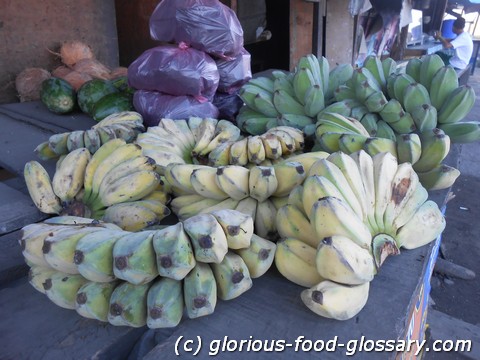Deutsch: Grüne Saba-Banane / Español: Plátano Saba Verde / Português: Banana Saba Verde / Français: Banane Saba Verte / Italiano: Banana Saba Verde
Saging na Saba (Hilaw) refers to the unripe, green version of the Saba banana, a type of cooking banana that is popular in the Philippines and other tropical regions. Unlike the sweeter dessert bananas like the Lakatan, the Saba banana is larger, angular in shape, and has a starchy consistency that makes it ideal for cooking. When green and unripe, it has a firm texture and mild flavor, making it versatile for both savory and sweet dishes.
Description
Saging na Saba is widely used in Filipino cuisine due to its versatility. When unripe and green (Hilaw), it is excellent for cooking as it holds its shape well and absorbs flavors beautifully. This type of banana is commonly used in dishes where bananas are boiled, fried, or included in stews. Its starchy content is similar to that of potatoes, making it a substantial and satisfying ingredient in many meals.
Application Areas
In the culinary world, Saging na Saba (Hilaw) is primarily used in traditional Filipino dishes. It's often cooked in soups like "Pochero" and "Nilaga," where it adds a subtle sweetness and texture to the broth. Green Saba bananas are also the main ingredient in "Minatamis na Saging," a sweet stewed banana dish, though they must be slightly ripe for this preparation. Additionally, they can be fried to make "Maruya" (banana fritters) or "Turon" (banana spring rolls), where their starchy body becomes tender and slightly sweet when cooked.
Well-Known Examples
- Nilagang Saba: Boiled green Saba bananas, often eaten as a snack or side dish.
- Banana Chips: Thinly sliced and fried green Saba bananas, seasoned with salt or sugar.
- Pochero: A Filipino stew with green Saba bananas as one of the vegetables in a tomato-based broth.
Treatment and Risks
Green Saba bananas are a healthy addition to the diet, rich in vitamins and minerals, dietary fiber, and resistant starch, which may aid in blood sugar management and digestive health. However, because they are consumed cooked rather than raw, it's important to prepare them properly to ensure they are fully cooked and easily digestible. There are no specific risks associated with consuming green Saba bananas, provided they are prepared and cooked appropriately.
Recipes
Boiled Saging na Saba Recipe:
Ingredients:
- 6 green Saba bananas
- Water for boiling
- A pinch of salt (optional)
- Clean the Saba bananas by rinsing under cold water. Trim the ends and peel them.
- In a large pot, bring enough water to cover the bananas to a boil. Add a pinch of salt if desired.
- Add the bananas to the boiling water. Lower the heat to a Simmer and cover the pot.
- Cook for about 15-20 minutes, or until the bananas are tender and easily pierced with a fork.
- Remove the bananas from the water and let them cool slightly before serving.
Similar Terms or Synonyms
In other contexts, Saging na Saba (Hilaw) might simply be referred to as green cooking bananas or unripe Saba bananas. They are distinct from plantains but are used in similar ways in cooking due to their starchy texture.
Summary
Saging na Saba (Hilaw) is a staple ingredient in Filipino cuisine, known for its starchy texture and versatility in both savory and sweet dishes. As an unripe cooking banana, it offers a unique flavor and consistency that enriches a variety of traditional Filipino recipes, from hearty stews to delightful snacks, showcasing the cultural importance and culinary diversity of bananas in the Philippines.
--

Related Articles to the term 'Saging na Saba (Hilaw)' | |
| 'Saging na Saba (Hinog)' | ■■■■■■■■■■ |
| Saging na Saba (Hinog) refers to the ripe version of the Saba banana, a type of cooking banana that is . . . Read More | |
| 'Maruya' | ■■■■■■■■ |
| Maruya is a traditional Filipino snack made from bananas, typically Saba bananas, which are battered . . . Read More | |
| 'Saging (Lakatan)' | ■■■■■■■ |
| Saging (Lakatan) refers to a specific variety of banana that is popular in the Philippines and other . . . Read More | |
| 'Papaya (Hilaw)' | ■■■■■■ |
| Papaya (Hilaw) refers to the unripe, green papaya fruit commonly used in various culinary applications . . . Read More | |
| 'Lakatan' | ■■■■■■ |
| Lakatan refers to a variety of banana that is widely cultivated and consumed in the Philippines. Known . . . Read More | |
| 'Nilagang Gabi' | ■■■■■■ |
| Nilagang Gabi in the food context refers to a Filipino dish involving boiled taro (gabi) root. Taro is . . . Read More | |
| 'Saging' | ■■■■■ |
| Saging is a Filipino word for banana. In the Philippines, there are 2 kinds of Saging or Bananas available, . . . Read More | |
| 'Inihaw na Saba / Inihaw na Saging na Saba' | ■■■■■ |
| Inihaw na Saba / Inihaw na Saging na Saba: Inihaw na Saging na Saba (grilled plantain or cooking banana . . . Read More | |
| 'Banana Cue' | ■■■■■ |
| In the food context, \'Banana Cue\' . . . . . . Read More | |
| 'Siling Haba' | ■■■■■ |
| Siling Haba, commonly known in English as long chili pepper or finger chili, is a type of chili pepper . . . Read More | |
